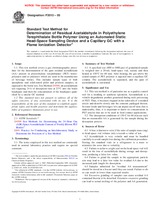We need your consent to use the individual data so that you can see information about your interests, among other things. Click "OK" to give your consent.
ASTM F2013-05
Standard Test Method for Determination of Residual Acetaldehyde in Polyethylene Terephthalate Bottle Polymer Using an Automated Static Head-Space Sampling Device and a Capillary GC with a Flame Ionization Detector
STANDARD published on 1.4.2005
The information about the standard:
Designation standards: ASTM F2013-05
Note: WITHDRAWN
Publication date standards: 1.4.2005
SKU: NS-52446
The number of pages: 9
Approximate weight : 27 g (0.06 lbs)
Country: American technical standard
Category: Technical standards ASTM
Annotation of standard text ASTM F2013-05 :
Keywords:
AA test, acetaldehyde, carbonated soft drink, ground parison AA, PET bottles, 24 hours headspace, water, ICS Number Code 55.100 (Bottles. Pots. Jars)
Additional information
| Significance and Use | ||||
|
This test method is of particular use as a quality control tool for a molding or synthesis operation. Acetaldehyde is a volatile degradation product generated during melt processing of PET. Thus, it becomes trapped in the sidewalls of a molded article and desorbs slowly into the contents packaged therein. In some foods and beverages AA can impart an off-taste that is undesirable, thus, it is important to know its concentration in PET articles that are to be used in food contact applications. The desorption conditions of 150 C for 60 min are such that no measurable AA is generated by the sample during the desorption process. |
||||
| 1. Scope | ||||
|
1.1 This test method covers a gas chromatographic procedure for the determination of the ppm residual acetaldehyde (AA) present in poly(ethylene terephthalate) (PET) homo-polymers and co-polymers which are used in the manufacture of beverage bottles. This includes sample types of both amorphous and solid-stated pellet and preform samples, as opposed to the bottle test, Test Method D 4509, an acetaldehyde test requiring 24 h of desorption time at 23°C into the bottle headspace and then the concentration of the headspace quantified by a similar GC method. 1.2 This standard does not purport to address all of the safety concerns, if any, associated with its use. It is the responsibility of the user of this standard to establish appropriate safety and health practices and determine the applicability of regulatory limitations prior to use. |
||||
| 2. Referenced Documents | ||||
|



 Cookies
Cookies
